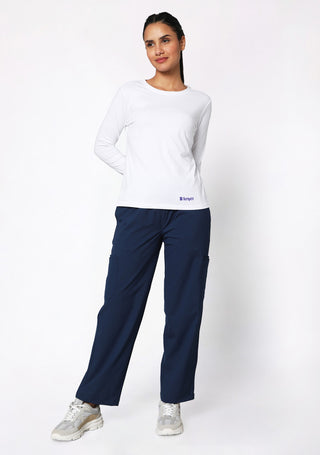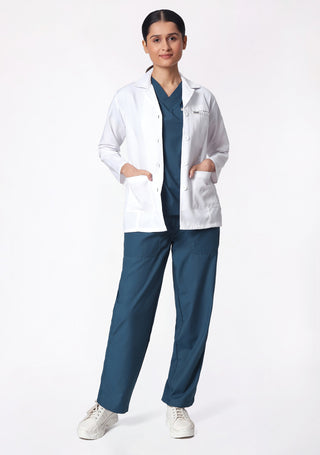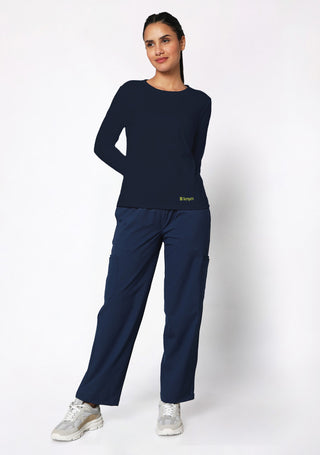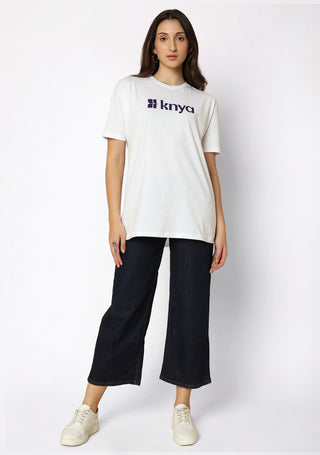In the fast-paced, demanding world of healthcare, your scrubs are your second skin. The perfect fabric keeps you cool under pressure, allows you to move with ease, and stands up to repeated washing.While style and fit matter, fabric choice plays the most critical role in performance, durability, and all-day comfort.
Why Fabric Matters
Medical scrubs aren’t just another uniform—they are functional tools. The right fabric ensures:
-
Breathability: Essential for long shifts and high-stress situations.
-
Moisture-wicking: Keeps you dry when you're constantly on the move.
-
Durability: Withstands frequent washing and the wear-and-tear of clinical life.
-
Comfort and Flexibility: Supports freedom of movement without sacrificing structure.
-
Professional Appearance: Maintains a clean, wrinkle-free look throughout the day.
Choosing the perfect fabric means investing in your own efficiency and well-being.
For our male healthcare professionals, we offer a wide range of comfortable and stylish scrubs for men, designed to enhance both comfort and professional image
Common Fabric Blends in Medical Scrubs
Medical scrubs are often made from blends rather than single fabrics, offering the benefits of multiple materials. Here are the most common types:
Cotton
-
Pros: Natural, breathable, soft against the skin, hypoallergenic.
-
Cons: Wrinkles easily, less durable, may shrink in the wash, slower to dry.
-
Best For: Clinical settings with low exposure to bodily fluids or chemicals; sensitive skin types.
Polyester
-
Pros: Durable, wrinkle-resistant, dries quickly, retains color well.
-
Cons: Less breathable, can trap heat, may pill over time.
-
Best For: High-demand hospital environments and industrial laundering.
Spandex (or Elastane)
-
Pros: Adds stretch and flexibility, ideal for active professionals.
-
Cons: Less breathable when used in high percentages, can wear out faster.
-
Best For: Jobs requiring high mobility, like EMTs, physical therapists, or surgical techs.
Rayon (or Viscose)
-
Pros: Smooth texture, lightweight, drapes well, comfortable.
-
Cons: Can wrinkle, less durable than polyester or cotton.
- Best For: Office-based or lower-activity clinical environments.
Popular Fabric Blends and Their Benefits
Most scrubs combine multiple materials for performance optimization. Here are some popular combinations:
Cotton-Polyester Blend (e.g., 55% cotton, 45% polyester)
-
Benefits: Combines softness with durability. Fewer wrinkles than pure cotton, more breathable than pure polyester.
-
Perfect For: General-purpose scrubs that need daily washing and long-term use.
Polyester-Spandex Blend (e.g., 92% polyester, 8% spandex)
-
Benefits: Excellent stretch, retains shape, easy to care for, wrinkle-resistant.
-
Perfect For: Active roles where flexibility and fit are important.
Cotton-Rayon-Spandex Tri-blend
-
Benefits: Ultra-soft feel, drapes well, breathable, and slightly stretchy.
-
Perfect For: Those who prioritize comfort and style, such as private practices or outpatient clinics.
Matching Fabric to Your Role
Your role in the medical field often dictates your uniform needs. Here's a tailored approach:
For Nurses and Nursing Assistants
-
Best Fabric: Polyester-cotton blend with added spandex.
-
Why: You're constantly moving and need something durable, breathable, and flexible. Look for moisture-wicking and stain-resistant options.
For Surgeons and OR Staff
-
Best Fabric: Lightweight polyester or polyester-cotton scrubs with antimicrobial treatment.
-
Why: Scrubs here must be sterile, cool, and quick to change. Wrinkle-free and fast-drying properties help in back-to-back procedures.
For Lab Technicians and Pharmacists
-
Best Fabric: Cotton-rich or rayon blends.
-
Why: Comfort is key, but you also want a professional, polished look for desk-based or lab work with lower contamination risk.
We believe you deserve the best. Shop our amazing selection of lab coats right here
For EMTs and Emergency Staff
-
Best Fabric: Stretchy polyester-spandex blend with moisture-wicking and soil release properties.
-
Why: Flexibility and resilience are crucial. You also need something easy to clean after exposure to outdoor environments.
Other Key Fabric Features to Consider
Fabric quality is about more than material percentages. Look for these added features:
Moisture-Wicking Technology
Helps evaporate sweat and keep you dry during long shifts. Often seen in athletic or performance scrubs.
Antimicrobial Finish
Reduces the growth of bacteria and odor. Ideal for infection-control zones and high-contact roles.
Stain Resistance
Prevents blood, fluids, and ink from seeping into the fibers. Scrubs look newer for longer.
Fade Resistance
Maintains color intensity after multiple washes, especially important for darker scrub shades.
Wrinkle Resistance
Low-maintenance and professional-looking even after 12-hour shifts.
Climate and Care: Matching Fabric to Environment
Where you work matters, too. Humid, hot, or air-conditioned environments can affect how a fabric feels.
-
Hot & Humid Locations: Choose lightweight cotton-polyester blends or rayon-based fabrics that allow airflow.
-
Cool or Air-Conditioned Settings: Go for slightly thicker fabrics like poly-cotton blends or add a base layer under breathable rayon blends.
-
Frequent Washing: Prioritize fabrics with strong polyester content for longevity and fade resistance.
Care Instructions Matter
Some fabrics require delicate handling, while others can be machine-washed in hot water. Read the care label! In healthcare, it's common to wash scrubs at high temperatures for hygiene your fabric must tolerate it.
Sustainability and Skin Sensitivity
If sustainability is part of your lifestyle or you have sensitive skin, consider:
-
Organic Cotton Scrubs: Naturally hypoallergenic, chemical-free, but may cost more.
-
Bamboo-Blend Scrubs: Antibacterial, ultra-soft, and sustainable, though slightly less durable.
Final Tips for Selecting the Right Scrub Fabric
-
Try Before You Buy: If possible, wear the scrubs for a test shift to see how they feel after hours of wear.
-
Check Stretch Zones: Some scrubs have reinforced or stretch panels only in specific areas like the back or knees ideal for mobility without full spandex coverage.
-
Balance Price and Performance: Higher-quality fabrics often last longer and feel better, making them more cost-effective over time.
Don’t Compromise on Hygiene: Always opt for machine-washable fabrics that can be sanitized effectively.













